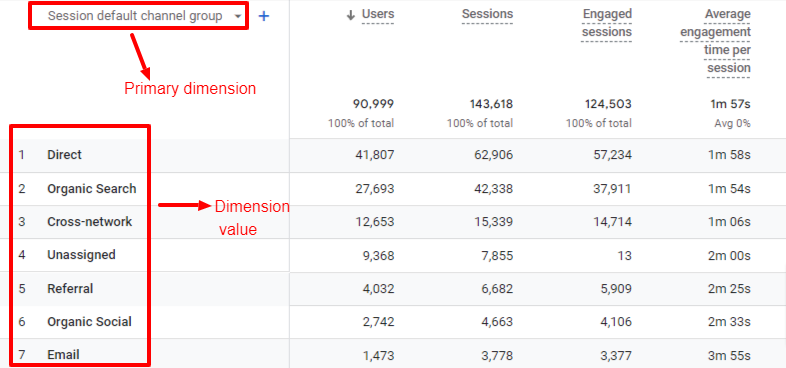Optimizing Search Engine Optimization with Secondary Dimension in Google Analytics
Optimizing Search Engine Optimization with Secondary Dimension in Google Analytics
Blog Article
Maximize Coverage Accuracy With Additional Measurement in Google Analytics
Understanding exactly how to make the most of reporting precision with secondary measurements in Google Analytics can dramatically enhance the deepness of insights obtained from information analysis. By incorporating additional dimensions tactically, online marketers can uncover concealed patterns and connections that may not be immediately noticeable when evaluating key metrics alone.
Understanding Additional Measurements in Google Analytics
Second dimensions permit customers to section and even more explore data beyond the key dimension picked. While the primary measurement may show the total number of page sights, including a secondary measurement such as 'source/medium' can supply insights right into where the website traffic stemmed from.
Moreover, comprehending secondary measurements is essential for developing much more customized reports customized to specific business goals. By selecting the ideal mix of main and additional dimensions, analysts can uncover patterns, trends, and connections that may otherwise stay surprise. This nuanced approach to information evaluation empowers organizations to make enlightened decisions based on an extensive understanding of user actions across numerous measurements.

How to Apply Additional Dimensions
When leveraging additional measurements in Google Analytics, the practical application involves selecting specific information criteria to more fine-tune insights beyond the main dimension's range. To use second measurements efficiently, begin by accessing the record or dataset where you want to delve deeper into the information. Within Google Analytics, situate the main dimension that you are currently assessing. Once identified, click the dropdown menu classified "Additional Dimension." This activity will certainly expose a checklist of additional parameters that can be contributed to your evaluation. Select the secondary measurement that lines up with your logical goals, such as 'Source/Medium,' 'Device Classification,' or 'Location.' By choosing a secondary dimension, you can get extra detailed insights into individual habits, demographics, or procurement channels. Bear in mind that second measurements aid provide context and granularity to your primary measurement data, enabling you to draw out even more purposeful and workable understandings from your Google Analytics records.
Leveraging Secondary Dimensions for Insights
Using additional measurements in Google Analytics enables a more extensive analysis of data, supplying valuable understandings beyond the key dimension's scope. By leveraging additional dimensions, users can delve much deeper into the efficiency metrics of their internet site or app, discovering covert patterns and patterns that might not be right away noticeable when only looking at main dimensions.
One trick benefit of using secondary measurements is the capability to segment and filter data much more exactly. This can assist analysts and marketing professionals much better recognize the behavior of particular customer sectors, such as new site visitors versus returning site visitors, or web traffic originating from different geographic places.
Moreover, secondary measurements enable users to contrast and comparison different data points within the same record, offering a more alternative sight of efficiency (Secondary Dimension in Google Analytics). For instance, pairing the main measurement of touchdown web pages with additional dimensions like tools or demographics can disclose which web pages are most effective in involving users on various tools or from different demographic groups.
Basically, leveraging secondary measurements in Google Analytics equips individuals to remove richer insights from their information, resulting in even more informed decision-making and eventually, boosted performance.
Finest Practices for Secondary Measurements
When examining information in Google Analytics, incorporating secondary measurements successfully enhances the depth of insights derived from the primary Clicking Here metrics. Selecting pertinent secondary dimensions helps in giving context and a more clear understanding of the data being checked out.
Additionally, it is recommended to restrict the variety of secondary measurements utilized in a solitary report to avoid overwhelming the analysis with as well much details. Concentrating on a couple of key second dimensions each time can cause even more workable and focused insights. In addition, think about experimenting with different combinations of additional and primary measurements to reveal special patterns and patterns that may not appear when looking at the data alone.
Advanced Analysis Methods With Second Dimensions
Checking out detailed data partnerships through the critical application of secondary dimensions can introduce nuanced insights that boost the deepness of analysis in Google Analytics. By incorporating second measurements with main information collections, advanced analysis methods can be used to draw read review out valuable information.
In addition, second dimensions can boost the evaluation of conversion courses by supplying extra context. Recognizing the different touchpoints an individual communicates with prior to transforming can be critical in maximizing the consumer journey - Secondary Dimension in Google Analytics. By using second dimensions to explore specifics such as traffic resources or gadgets used, marketing professionals can tailor techniques to target high-converting channels efficiently
Verdict

To improve data evaluation and gain much deeper insights right into user actions, recognizing navigate to this website secondary measurements in Google Analytics is imperative - Secondary Dimension in Google Analytics. Additional dimensions permit users to section and further study information beyond the main dimension selected. While the primary dimension might present the total number of page sights, including a secondary measurement such as 'source/medium' can give insights right into where the traffic stemmed from.When leveraging additional measurements in Google Analytics, the useful application involves choosing certain information criteria to more refine insights beyond the main measurement's extent. Bear in mind that secondary measurements help supply context and granularity to your main dimension information, allowing you to draw out even more significant and actionable understandings from your Google Analytics reports
Report this page